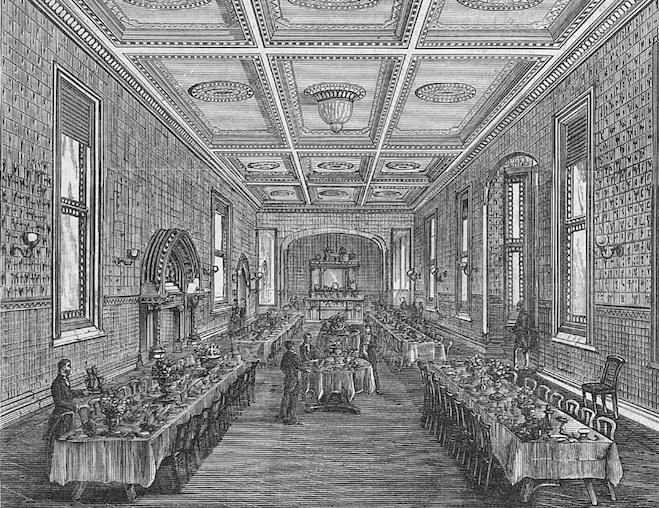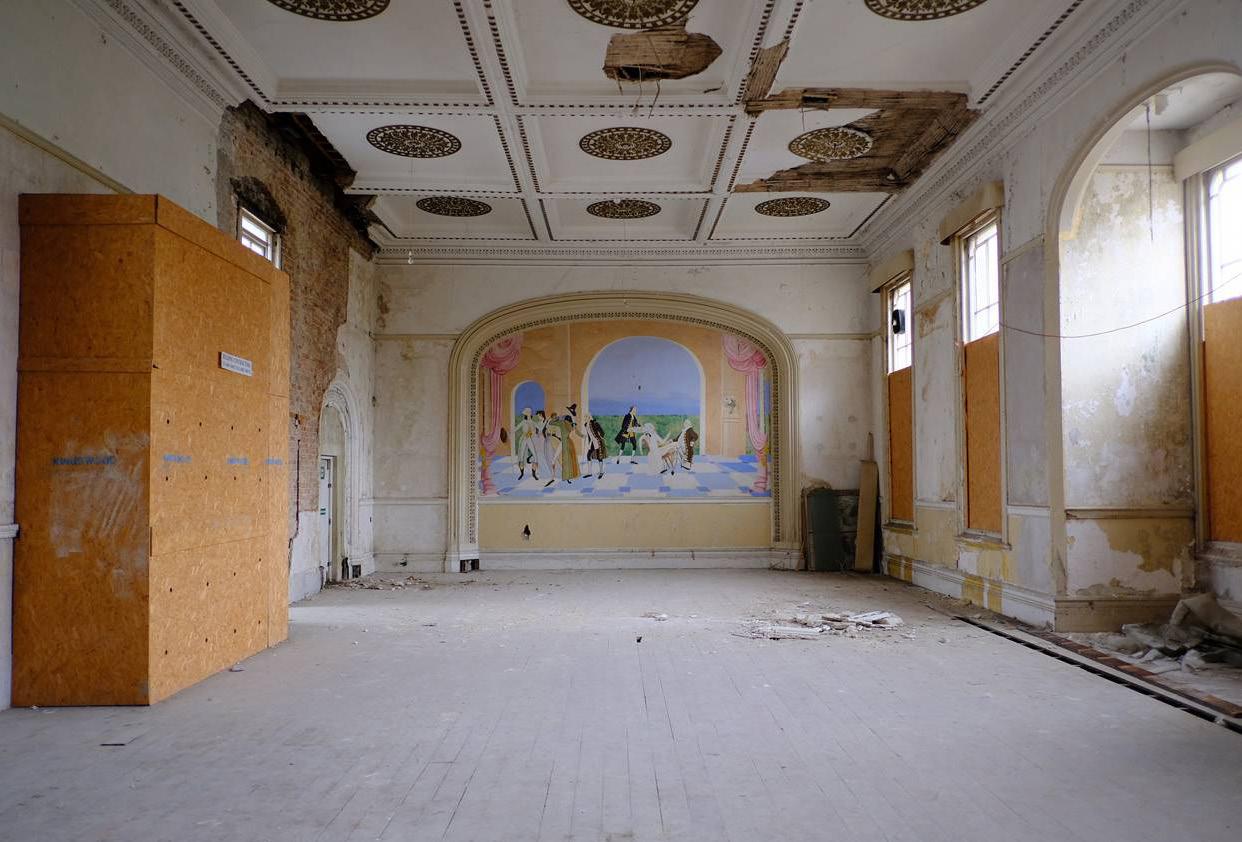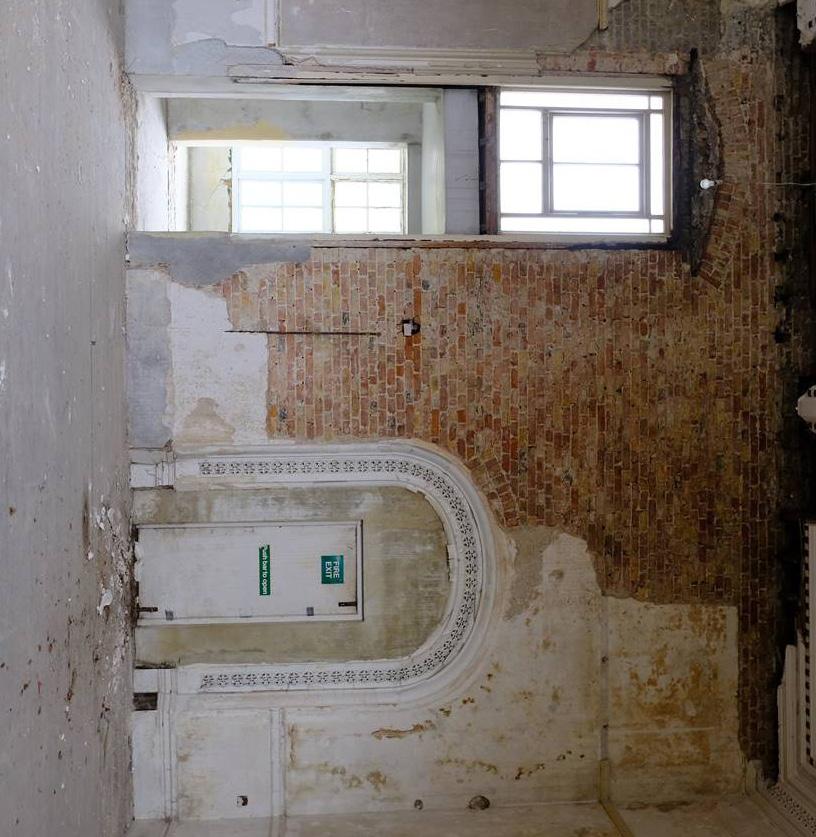
8 minute read
The grand old Granville - new plans afoot for the once-famous hotel
The grand old Granville

Advertisement
Postcard circa 1915

It’s been the ambition of great men, the ruin of wealthy men; it’s survived bankruptcy, bombings and numerous owners. The history of the Granville is a rollercoaster ride of highs and lows, but a community project could see a long abandoned section get a new lease of life, bringing the 19th century building right up to date

It stands on the East Cliff, a mixture of private flats and long abandoned cavernous rooms where once writers, royals, the rich and the famous came to holiday. The Granville opened in 1869 with an inaugural ball the likes of which Thanet had never seen. Today the same ballroom stands derelict, and is one of the spaces earmarked for an ambitious new project that could see parts of the Granville Hotel restored and brought back into community use, to host exhibitions, performances, events and conferences. If all goes to plan, the bar, which is rumoured to have in the past propped up celebrities including Noel Coward and Ian Fleming, and certainly Oscar Wilde, could once again be welcoming visitors with food and drink, and the kitchens reopened to cater for large events including weddings.
On the lower ground floor, plans for forgotten interlinked rooms and chambers include turning them into creative studios offering affordable workspaces and workshops, something Heritage Lab, a new community-interest company behind the project, says Ramsgate is lacking. It sees Ramsgate’s rich architectural history as the key to unlocking regeneration in the area. With over 450 listed buildings, Ramsgate has been designated the UK’s first Heritage Action Zone and the group have set their sights on the Granville. The history of the Granville is itself a marvel of creative ambition. It was a unique venture by architect Edward Welby Pugin, whose mainstay was designing and completing over 100 Catholic churches. Edward was the son of architect Augustus Pugin, famed nationally for his role in the Gothic Revival style of the 19th century, and his work on the Palace of Westminster, but more locally for their family home, the Grange, and St Augustin’s Church, which stand on the West Cliff. The Granville bookends the Pugin family stamp on the town, standing as it does on the town’s East Cliff.



MAKE YOUR OWN MORPH, GROMIT OR SHAUN MODEL!

FILM SCREENINGS INCLUDED
SAT 15 FEB DREAMLAND, BALLROOM
Ramsgate’s creative sector is booming, with investment, business networks and suitable premises for workspace vital to help it grow further. Research has found that Ramsgate’s cultural sector is now three times larger that it was ten years ago, largely thanks to an influx of new and mostly small businesses. Ramsgate gets more creative —
The research is the result of an online public survey conducted by Heritage Lab CIC and Canterbury Christ Church University, to which 228 people responded.
It has helped map creative businesses in the area and found the majority of people who took part are in music, performing and visual arts, followed by film, radio and television, and finally crafts, publishing, advertising, marketing and design.
It comes in the wake of investment in the area as part of the Thames Estuary Production Corridor (TEPC). Launched in 2017, TEPC has identified the Thames Estuary region, stretching from London to the coasts of Essex and Kent, as an area to be transformed into a global powerhouse for cultural and creative production, creating an estimated 50,000-plus jobs. £4.3m was awarded to Kent in January 2019 by the Department for Digital, Media, Culture and Sport to help kickstart this vision.
Funded by Locate in Kent and The Arts Council, the research suggests Ramsgate could have a role to play in this bigger picture.
Professor Mike Weed of Canterbury Christ Church University says: “It shows a thriving and growing sector that has benefited from the migration of businesses from London, but is also in need of suitable premises locally, business support and investment to expand further.”
Rob Kenyon, CEO and founder of Heritage Lab CIC, says: “It highlights the potential for Ramsgate’s amazing heritage buildings to help fulfill the need for suitable business premises. Heritage Lab will use the report to help identify sites to regenerate into curiously creative spaces.” In 1863, this was an area ripe for development when Ramsgate station arrived on the sea front. Pugin designed a row of eight terraced houses in the gothic style, each with a private entrance. Guests had use of a reading, smoking, billiard and ladies’ drawing room, along with a top-ofthe-range spa, including Turkish, hydropathic, ozone, and hot and cold seawater baths. A feat of engineering, the baths made the Granville famous, and the hotel became a UK landmark. The luxurious finish - details include an enormous red marble-base-pillared fireplace dominating the ballroom, complete with a New Zealand satinwood sprung floor; a billiard room with decorated black and gold ceiling panels, satin-wood walls and velvet and gold upholstery; encaustic tiles paved the entrance hall from which a marble staircase led upstairs - and the scale of the project, with its unrivalled spa and designs for new roads and gardens, ended in Pugin’s bankruptcy. His last addition was the Great North East Tower, still visible across the town today, where salt and freshwater tanks were stored. Lit up at night, the tower could be seen from Ostend, Dunkirk, and Calais. Two years later, Pugin died. It was 1875 and he was just 41.
The next owner was Edmund Francis Davis, a rich solicitor from Broadstairs. He completed many of Pugin’s designs, developing and opening Victoria Gardens, a treelined promenade along the clifftop, controversially erecting a kiosk to charge an entrance fee, which today sells ice creams in the summer. He

completed the zigzag road linking the hotel to the beach below, a project that had seen several mishaps and serious accidents. Opened in 1878, “Granville Marina” offered a row of shops and restaurants. At its entrance stood the Establishment, where concerts were held. Davis also introduced the Granville Express, a bespoke train service direct from London.
But other business interests saw Davis run into financial difficulties. In 1887 he too filed for bankruptcy, having fled to Chicago the year before where he eventually died.
Two years later the hotel was bought by hoteliers Spiers & Pond, who renovated and added balconies and a veranda which stretched the length of the building. The hotel boasted 300 rooms, accommodating 250 guests. The Granville was back in business - until war broke out.
In 1915 it was taken over by the War Office and converted into a hospital for Canadian wounded. For over two years injuries, shell shock and nerve disease were treated here, but after enemy bombs killed two and injured 17 the hospital moved to Derbyshire.
The years between the wars saw the Granville once more refurbished and returned to luxury, but in 1940 it closed its doors for ever. After the war it was sold at a loss having sustained bomb damage to one corner.
The following years until 1991 saw the building converted into luxury flats with a bar, and a basement jazz club in the 1950s. Over the years the Granville continued to change owners with various designs on the building. From casino to disco, none of these materialised and the building fell into disrepair, with whole areas, including the baths, demolished.
In the 1990s the bomb-damaged corner was finally rebuilt as Granville Court, earning the building a Grade II listing. But from its glamorous past, it has sunk into obscurity, and now sits in an area ranked in the five per cent of most deprived wards in England.
The new proposals could see whole sections of the building, unseen by the public for decades, brought back into use. Heritage Lab has secured a legal agreement with the owner to buy the 999-year leasehold to the seafront Granville Bars. The company has until November 2020 to raise £485,000 through a combination of grants and crowdfunding. Then work would start on what Heritage Lab have described as “a thriving creative hub and world class events space”, open for business from next year, and fully completed by 2025.
Rob Kenyon, CEO of Heritage Lab CIC, urges people to back the project. “This really will happen, providing that we raise the £485,000. We have a cast-iron legal agreement in place. If the community wants to support this, it definitely will take place.”
For more information about the project and to get involved visit heritagelab.org.uk
Get Involved —
ATTEND Heritage Lab and Canterbury Christ Church University are hosting a networking event on 5 February, to launch their economic analysis on the impact of the creative sector on Ramsgate. Hear about Arts Council England’s 2020-30 strategy and the work of Creative Estuary, and get business advice from Locate in Kent. Register online at curiouslycreative.eventbrite.com
JOIN Become a member of Heritage Lab. It’s free and you will be kept up to date on the Pugin Chambers project and other news. Help is needed with communications, design, social media, film work, flyering, fundraising, history, genealogy and administration.
DONATE Heritage Lab’s Pugin Chambers has been chosen by Crowdfunder as one of their Big Impact projects for 2020. Sign up to be the first to hear about the launch in April heritagelab.org.uk/join




09 - 05 - 20 Tickets £12 adv+ bf olbyssoulcafe.co.uk 01843 448595










